瞭解將電腦連接到電視的多種方法,以及優化觀看體驗的方法。
按兩下或主題以取得詳細資料:
DVI(DVI-D 或 DVI-I)、HDMI、VGA(或 D-Sub)或 DisplayPort* 連接器是什麼樣子的?

S-Video、複合、RCA 或分量 (YPbPr) 連接器是什麼樣的?

Intel 顯示晶片是否支援TV-out?
是的。只要您的電腦有電視輸出連接器,Intel 圖形就支援輸出到模擬或數字電視。請與您的電腦製造商聯繫,以獲取適用於您的電腦型號的支持和測試的電視配置。什麼類型的連接器可以使用TV-out?
四種類型的TV輸出連接器用於連接到外部電視。這些類型是 DVI、HDMI、VGA 和 DisplayPort。請聯絡您的製造商,以查看哪種連接器與您的電腦和電視相容。連接到電視時支援哪些連接器?
您的電腦的輸出埠必須與電視上的輸入埠之一相匹配。您也可以使用將一種格式轉換為另一種格式的適配卡纜線進行連接,例如 VGA 轉換為 HDMI。我可以將電腦的 VGA 連接到電視嗎?
是的,只要計算機和電視都有VGA埠就可以。查看電視用戶手冊以獲取有關支援的解析度的資訊。一些電視用戶手冊將VGA埠稱為D-sub連接器。我可以使用 VGA 到 S-Video、VGA 到 HDMI 或 DVI 到 HDMI 纜線連接到電視嗎?
這些纜線可能適用於也可能不適用於您的電腦。這在很大程度上取決於您的硬體,包括但不限於計算機的視頻埠支援的內容、電纜本身和/或電視。建議您向計算機製造商詢問您的電腦是否支援這些電視電纜,以及哪些電視電纜經過驗證可與您的電腦配合使用。
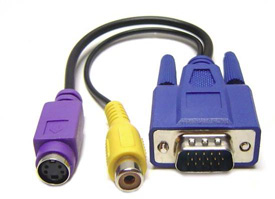
圖1 VGA 轉 S-Video 和 Composite Video
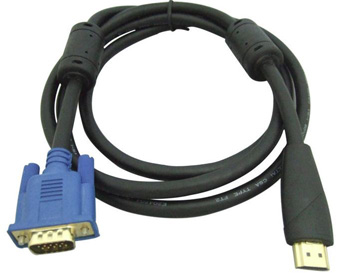
圖 2 VGA 至 HDMI
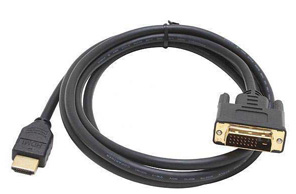
圖 3 DVI 至 HDMI
如何將我的電腦連接到電視?
首先確定用於將電視連接到電腦的連接器類型。接下來,將電腦連接到電視。連接后,您可能需要在圖形設置中將顯示器切換到電視。- 按下 Ctrl + Alt + F12。
- 按兩下 「多個顯示器」,在「主要顯示器」或「第二顯示器」中選擇電視。
- 按兩下 電視>常規設置。。
- 按兩下 確定 或 應用應用。
我可以取得支持的電視清單嗎?
您的電腦製造商通常可以提供已使用您的電腦型號進行測試的電視機清單。我可以無線連接到電視嗎?
是的。您可以使用Intel® 無線顯示技術 (Intel® WiDi) 技術進行連接。
- 2x
- 1.75x
- 1.5x
- 1.25x
- 1x, selected
- Chapters
- descriptions off, selected
- subtitles settings, opens subtitles settings dialog
- subtitles off, selected
- en (Main), selected
This is a modal window.
Beginning of dialog window. Escape will cancel and close the window.
End of dialog window.
This is a modal window. This modal can be closed by pressing the Escape key or activating the close button.
This is a modal window. This modal can be closed by pressing the Escape key or activating the close button.
是否支援與 Apple Mac* 電腦一起使用的 Mini DisplayPort 配接器?
查看 Apple 產品規格。我已將電腦連接到電視。如何將輸出切換到電視?
- 檢查您的顯示屬性。按 Ctrl+Alt+F12。在“顯示”下,應選擇 “電視 ”。
- 某些移動系統具有可在顯示器之間切換的快速鍵組合,例如 Fn + F5。請查看使用者手冊,了解系統的特定資訊。
- 確保您的電視在正確的輸入頻道上。有些電視有多個輸入源。您的電視應設置為您的電腦與系統連接的輸入。
- 切換到電視時,系統監視器可能會在切換到電視時關閉。
我已將電腦連接到電視。為什麼它無法識別電視?
此問題可能由於多種原因而發生,包括:
- 電視未設置為接收來自系統的輸入。
- 電視未配置為活動狀態。
- 連接電視和系統的纜線壞了,或者使用了系統無法識別的不受支援的適配卡。
- 電視未開。
- 系統可能未正確配置為顯示在電視上。
- 電視壞了。
請按照以下步驟解決這些問題
- 安裝最新 Intel® Graphics Driver。
- 打開電視。
- 使用電視螢幕功能表將輸入源配置為來自電視連接。
- 導航到 Intel® Graphics Control Panel 的“顯示器/設備”選項卡,並將電視指定為主顯示器或替代顯示器之一。
- 請卸下所有正在使用的適配卡,並測試第二根纜線,以驗證纜線不是問題所在。
- 更新系統的 BIOS(有關如何執行此作的資訊,請聯絡您的系統製造商)。
- 如果確定您的顯示設備已損壞,請向顯示器製造商尋求進一步説明。
如何調整電視的輸出?
使用Intel® Graphics Control Panel (Intel® GCP):- 按下 Ctrl + Alt + F12。
- 在 “顯示”下,按兩下「 監視器/電視設置 」以查看可以更改的可用設置。
- 按兩下 確定 或 應用應用。
為什麼我的電視輸出是黑白的?
許多問題可能會導致黑白輸出:- 驅動程式問題:驗證您的系統是否安裝了最新的驅動程式。您可以從電腦製造商處獲取最新的驅動程式,因為它們可以具有特定於您的系統的自定義項。一般驅動程式也可在 Intel 下載中心取得。
- 接頭問題:檢查所使用的纜線或適配卡是否已牢固地連接至系統和電視。
- SCART 連接器僅支援復合視頻。
- 如果您在系統上使用S-Video輸出,則只能獲得黑白圖像。使用 S-Video 輸出時,您必須使用 S-Video 轉 SCART 轉接器連接到電視。
- 電視模式:驗證您的系統是否與電視使用相同的模式(PAL 或 NTSC)。
- 硬體問題:檢查您是否將系統直接連接到電視,而不是通過任何其他設備。
為什麼我無法為電視選擇更高的解析度?
某些解析度不適用於某些連接類型。您使用的連接器還可以決定適用於您的設備的解析度。請洽詢製造商,您的電視可能需要驅動程式。為什麼我可以看到 Windows* 桌面的中心,卻看不到頂部、底部和側面?
當只有螢幕中央可見時,稱為過掃描。這個問題有時可以通過調整圖形適配器縮放選項來解決。
- 按下 Ctrl + Alt + F12。
- 按一下 常規設置 ,然後轉到 顯示 選項並選擇 電視。
- 請參閱「全屏」複選框,選擇 「啟用」。
- 按兩下 應用 以查看問題是否已解決。
如果過掃描仍然存在,請嘗試使用水平和垂直滑塊調整圖像。
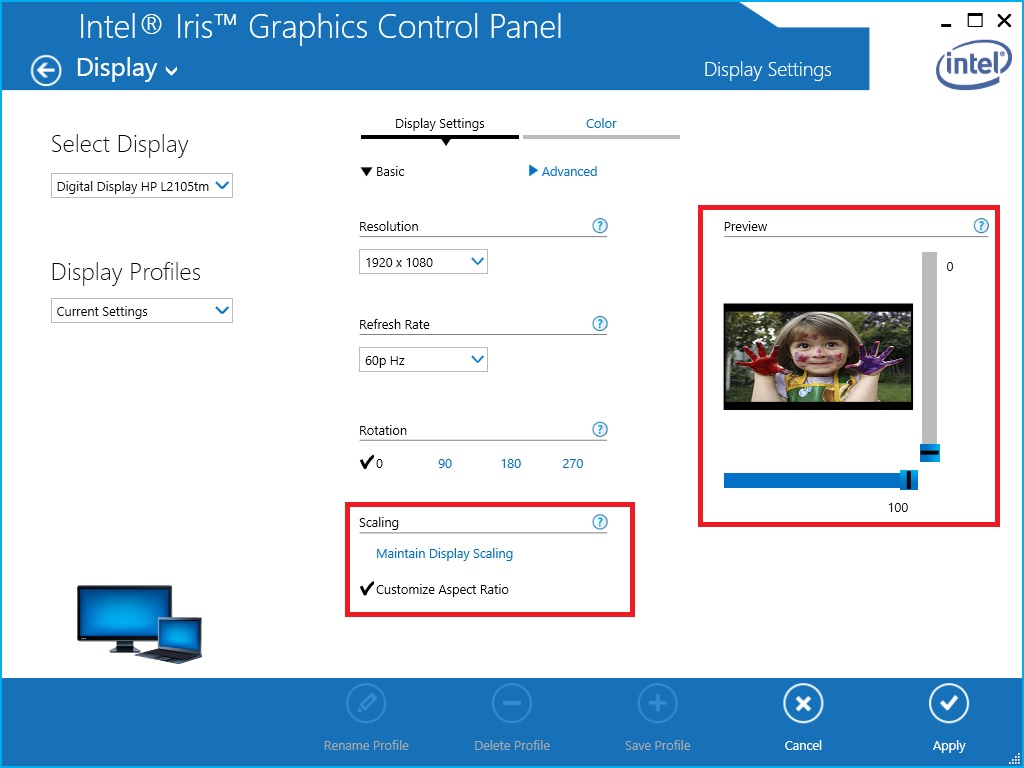
圖 4a: Intel® HD 顯示晶片控制台中的縮放選項。
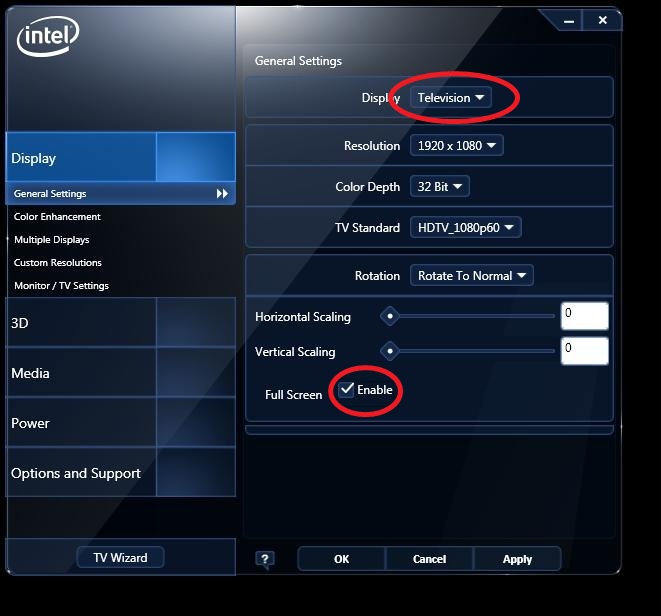
圖 4b: Intel® 繪圖和媒體控制台上的縮放選項
如果這些步驟無法解決問題,請轉到電視的設置功能表。檢查連接到系統的輸入的縮放選項設置。
為什麼它說不支持顯示器/電視設置?
您正在使用的連接可能不受支援。在聯繫顯示器和計算機製造商尋求支援之前,請檢查以下各項:
- 確保電纜已完全插入,並且顯示器已通電。
- 埠或電纜損壞也可能是問題所在。
- 檢查埠是否未在 BIOS 中停用。
- 嘗試使用其他埠或電纜(如果有的話)進行故障排除。